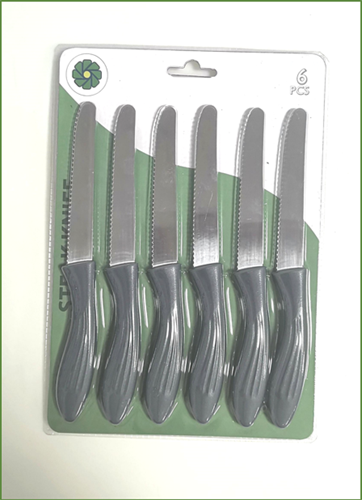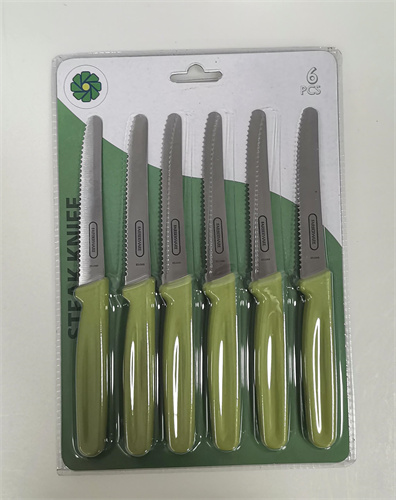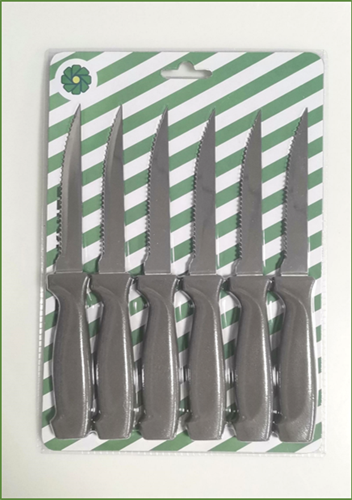

Views: 9000 Author: sales@insightknife.com.cn Publish Time: 2025-01-03 Origin: Site








Content Menu
● The Functionality of Wooden Handles
● Frequently Asked Questions regarding Steak Knife
>> 1. What are the advantages of wooden handles over plastic or metal handles?
>> 2. How should I care for my wooden-handled steak knives?
>> 3. Can wooden handles be customized?
>> 4. Are there specific types of wood that are better for knife handles?
>> 5. Why is the balance of a knife important?
Steak knives are an essential tool in any kitchen, particularly for those who enjoy a good steak. Among the various designs and materials available, wooden handles are a popular choice. This article explores the reasons behind the preference for wooden handles in steak knives, delving into their functionality, aesthetics, and historical significance.
One of the primary reasons for the popularity of wooden handles in steak knives is their ergonomic design. Wood provides a comfortable grip that conforms to the hand, allowing for better control while cutting. This is particularly important when slicing through tougher cuts of meat, where precision is key. The natural texture of wood also helps prevent slippage, ensuring that the user can maintain a firm hold on the knife. Unlike synthetic materials, which can feel slippery when wet or greasy, wood offers a tactile surface that enhances grip security. This ergonomic advantage is especially beneficial for individuals who may have difficulty with grip strength, making wooden-handled knives accessible to a broader range of users. Furthermore, the design of wooden handles often incorporates contours that fit the natural shape of the hand, reducing fatigue during extended use and allowing for a more enjoyable dining experience.
Wooden handles often contribute to the overall weight and balance of the knife. A well-balanced knife feels more stable in the hand, making it easier to maneuver. The density of wood can provide a satisfying heft that enhances the cutting experience. This balance is crucial for achieving clean cuts without excessive force, which can lead to accidents or uneven slices. Additionally, the weight distribution of a knife can affect how it feels during use; a knife that is too heavy at the blade may cause fatigue during prolonged use, while one that is too light may lack the necessary force to cut through tougher meats. The thoughtful design of wooden handles helps to create a harmonious balance that caters to the needs of both professional chefs and home cooks. This balance not only improves cutting efficiency but also enhances the overall enjoyment of the meal, as diners can effortlessly slice through their steaks without struggling with their utensils.

Wood is a poor conductor of heat, which means that wooden handles remain cooler to the touch compared to metal handles. This is particularly beneficial when using knives in a hot kitchen environment. The insulation properties of wood help to prevent burns and discomfort, allowing for a more enjoyable cooking experience. Furthermore, this characteristic can be advantageous when serving hot dishes, as the wooden handle will not transfer heat to the user’s hand, ensuring comfort during meal preparation and serving. This feature is often overlooked but plays a significant role in the overall user experience, especially in busy kitchens where efficiency and safety are paramount. Additionally, the insulating properties of wood can help maintain the integrity of the knife's edge, as extreme temperature fluctuations can sometimes affect the performance of metal blades.
Wooden handles bring a unique aesthetic appeal to steak knives. The natural grain patterns and colors of wood can enhance the overall presentation of the knife, making it a beautiful addition to any table setting. Many people appreciate the rustic charm that wooden handles provide, which can complement a variety of dining styles, from casual family meals to elegant dinner parties. The visual warmth of wood can create a welcoming atmosphere, making meals feel more special. Additionally, the beauty of wood is not just skin deep; it can also tell a story about the tree from which it came, adding a layer of connection to nature and craftsmanship that synthetic materials simply cannot replicate. This connection to nature can evoke feelings of nostalgia and appreciation for traditional craftsmanship, making wooden-handled knives not just tools but also conversation pieces that enhance the dining experience.
Wooden handles can be crafted from various types of wood, each offering distinct characteristics. From rich mahogany to lighter maple, the choice of wood can significantly impact the knife's appearance. Each type of wood has its own unique grain, color, and texture, allowing for a wide range of designs that can suit personal tastes and preferences. Additionally, wooden handles can be easily customized with engravings or unique designs, allowing for personalization that metal handles cannot offer. This customization can make wooden-handled steak knives ideal gifts for special occasions, as they can be tailored to reflect the recipient's personality or interests. The ability to create a one-of-a-kind piece adds to the emotional value of the knife, making it not just a tool but a cherished item. Moreover, the variety of wood types available means that consumers can choose handles that not only match their aesthetic preferences but also their values, such as sustainability and environmental consciousness.

The use of wooden handles in knives dates back centuries, reflecting a long tradition of craftsmanship. Historically, wood was one of the most accessible materials for knife makers, allowing for the creation of durable and functional tools. This tradition continues today, with many artisans still handcrafting wooden-handled knives, preserving the skills and techniques passed down through generations. The craftsmanship involved in creating a wooden-handled knife often includes intricate detailing and finishing that showcases the artisan's skill. This dedication to quality and tradition is evident in the final product, which often features unique characteristics that mass-produced knives lack. Collectors and enthusiasts often seek out these handcrafted pieces, valuing the artistry and history behind each knife. The revival of interest in artisanal products has led to a resurgence in the popularity of wooden-handled knives, as consumers increasingly appreciate the stories and craftsmanship that accompany these tools.
In many cultures, wooden-handled knives are preferred for their association with traditional dining practices. For instance, in steakhouses and fine dining establishments, wooden-handled steak knives are often seen as a mark of quality and authenticity. This cultural significance adds to the allure of wooden handles, making them a favored choice among chefs and home cooks alike. The preference for wooden handles can also be seen in various culinary traditions around the world, where the use of wood is deeply rooted in the culture. This connection to heritage and tradition enhances the dining experience, as it evokes a sense of nostalgia and appreciation for the culinary arts. In some cultures, the act of dining is not just about the food but also about the experience and the tools used, making wooden-handled knives a symbol of respect for the meal and the traditions surrounding it.
Caring for wooden-handled steak knives is essential to maintain their appearance and functionality. Unlike metal handles, wooden handles should not be submerged in water or placed in a dishwasher, as this can cause the wood to warp or crack. Instead, they should be wiped clean with a damp cloth and dried immediately to prevent moisture damage. Regular maintenance not only prolongs the life of the knife but also ensures that it remains hygienic for food preparation. Users should also be aware of the types of cleaning agents used, as harsh chemicals can damage the wood finish. By adopting proper cleaning techniques, users can keep their wooden-handled knives looking and performing their best for years to come. Additionally, understanding the specific type of wood used in the handle can inform users about the best care practices, as different woods may have unique properties that require tailored maintenance.
To keep wooden handles in optimal condition, regular oiling is recommended. Food-safe mineral oil can be applied to the handle to nourish the wood and prevent it from drying out. This not only enhances the appearance of the wood but also helps to protect it from stains and odors. Over time, exposure to moisture and oils from hands can lead to dullness and discoloration. By incorporating a simple oiling routine into their knife care, users can maintain the beauty and integrity of their wooden handles. Additionally, this practice can help to prevent the wood from cracking or splitting, ensuring that the knife remains a reliable tool in the kitchen. Users may also explore other natural oils, such as walnut or coconut oil, which can provide additional benefits and enhance the wood's natural luster. Understanding the importance of conditioning can transform the care of wooden-handled knives from a chore into a rewarding ritual that enhances the user's connection to their kitchen tools.
In conclusion, the preference for wooden handles in steak knives is rooted in a combination of functionality, aesthetic appeal, and historical significance. The ergonomic design, weight, and insulation properties of wood enhance the cutting experience, while the natural beauty and customization options make wooden handles a visually appealing choice. Furthermore, the rich tradition of craftsmanship associated with wooden knives adds to their allure. By understanding the reasons behind this preference, one can appreciate the artistry and practicality that wooden-handled steak knives bring to the dining experience. As culinary practices continue to evolve, the timeless appeal of wooden handles remains a testament to their enduring value in both professional and home kitchens. The choice of a wooden-handled steak knife is not merely a practical decision; it is an investment in quality, tradition, and the joy of cooking and dining.

Wooden handles provide a comfortable grip, better insulation from heat, and a more aesthetically pleasing appearance. They also tend to be less slippery than plastic or metal, especially when wet, which enhances safety during use.
To care for wooden-handled steak knives, avoid submerging them in water or placing them in the dishwasher. Instead, wipe them clean with a damp cloth and dry them immediately. Regularly apply food-safe mineral oil to nourish the wood and prevent it from drying out.
Yes, wooden handles can be easily customized. Many manufacturers offer options for engraving or unique designs, allowing users to personalize their knives. This makes wooden-handled steak knives great gifts for special occasions.
Certain types of wood, such as walnut, maple, and mahogany, are popular for knife handles due to their durability, aesthetic appeal, and resistance to moisture. Each type of wood has unique characteristics that can affect the knife's look and feel.
The balance of a knife is crucial for ease of use and control. A well-balanced knife feels stable in the hand, allowing for precise cuts without excessive force. This balance can reduce fatigue during prolonged use, making the cutting experience more enjoyable.
What Is The Difference between A Carving Knife And A Chef's Knife?
How Often Should I Sharpen My Bread Knife To Maintain Optimal Performance?
How Do Different Blade Shapes Affect The Performance of A Chef's Knife?
What Are The Best Practices for Storing And Caring for Steak Knives?
Are There Specific Types of Steel That Are Better for Steak Knives?